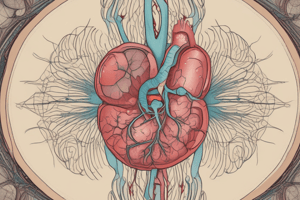Podcast
Questions and Answers
What is the primary function of nephrons in the kidney?
What is the primary function of nephrons in the kidney?
- Excretion of waste and maintenance of electrolyte balance (correct)
- Stimulation of red blood cell production
- Regulation of fluid and acid-base balance
- Filtration of blood
What is the structure formed by the collecting of tubules in the medulla?
What is the structure formed by the collecting of tubules in the medulla?
- Glomerulus
- Renal pyramid (correct)
- Nephron
- Renal corpuscle
What is the name of the network of capillaries surrounded by a double-layered epithelium in the nephron?
What is the name of the network of capillaries surrounded by a double-layered epithelium in the nephron?
- Vasa recta
- Efferent arteriole
- Glomerulus (correct)
- Bowman's capsule
What is the function of the efferent arteriole in the nephron?
What is the function of the efferent arteriole in the nephron?
What is the outer layer of the kidney called?
What is the outer layer of the kidney called?
Where does urine formation primarily occur in the kidney?
Where does urine formation primarily occur in the kidney?
Which blood vessels supply the kidneys with blood directly from the abdominal aorta?
Which blood vessels supply the kidneys with blood directly from the abdominal aorta?
What is the main functional unit responsible for filtering blood within the kidney?
What is the main functional unit responsible for filtering blood within the kidney?
In what kidney region does the countercurrent exchange system occur involving capillaries?
In what kidney region does the countercurrent exchange system occur involving capillaries?
Where does the renal vein typically lie in relation to the renal artery at the renal hilum?
Where does the renal vein typically lie in relation to the renal artery at the renal hilum?
Flashcards are hidden until you start studying
Study Notes
Kidney Anatomy: Nephrons, Renal Cortex, Renal Arteries, and Renal Medulla
The kidneys are vital organs responsible for various essential functions, including filtration, excretion of waste products, regulation of fluid and acid-base balance, and stimulation of red blood cell production. The kidney anatomy is complex and involves several components, including nephrons, renal cortex, renal arteries, and renal medulla.
Nephrons
Nephrons are the functional units of the kidney, responsible for excreting waste and maintaining electrolyte balance. Each kidney contains approximately 2 million nephrons. Nephrons are composed of a renal corpuscle, which includes a glomerulus and Bowman's capsule, and a renal tubule that consists of a proximal convoluted tubule, loop of Henle, distal convoluted tubule, and collecting duct. The glomerulus is a network of capillaries surrounded by a double-layered epithelium, Bowman's capsule, to form a renal corpuscle. An efferent arteriole drains the glomerulus and becomes the vasa recta that supplies the renal tubules.
Renal Cortex
The kidney's outer layer is called the renal cortex, which contains the renal pyramids and the renal corpuscles. The renal pyramids are conical structures formed by the collecting of tubules in the medulla, oriented with the base towards the cortex and apices towards the hilum. The papillae at the apices of the pyramids extend into minor calyces and drain via the collecting ducts at their tips, the area cribrosa. A collecting duct and the group of nephrons that it drains is referred to as a lobule.
Renal Arteries and Veins
The kidneys receive blood from paired renal arteries, which typically arise from the lateral aspect of the abdominal aorta at the level of L2. The renal artery then branches into anterior and posterior divisions, which further divide into segmental arteries. These arteries branch into interlobar arteries, which travel in a parallel fashion in between the major calyces and then branch further into arcuate arteries that run within the cortex of the kidney to finally become afferent arterioles, then peritubular capillaries to efferent arterioles. Renal veins drain the kidneys in a similar distribution, and the renal vein is generally anterior to the renal artery at the hilum.
Renal Medulla
The inner layer of the kidney is called the renal medulla, which contains the renal pyramids, where urine formation takes place. Urine passes from the renal pyramids into the renal pelvis, which is the funnel-shaped structure occupying the central cavity of each kidney and then narrows as it extends out to join the ureter. The renal medulla also contains the vasa recta, a network of capillaries integral to the countercurrent exchange system.
In summary, the kidney anatomy is complex and involves several components, including nephrons, renal cortex, renal arteries, and renal medulla. Each of these components plays a vital role in the kidney's function, such as filtering blood, reabsorbing vital substances, and excreting waste products. Understanding this anatomy is crucial for maintaining kidney health and treating various kidney-related disorders.
Studying That Suits You
Use AI to generate personalized quizzes and flashcards to suit your learning preferences.


